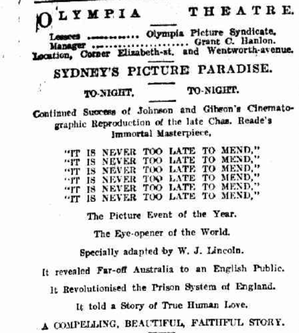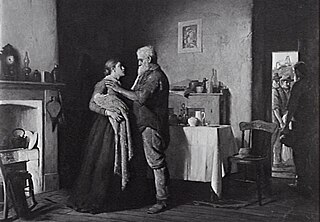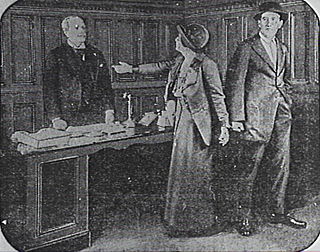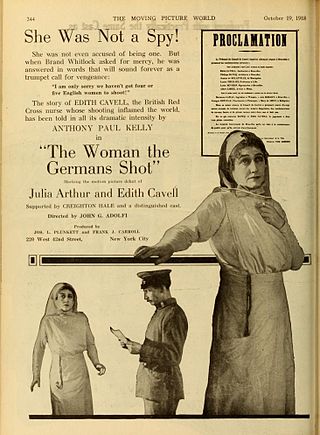Related Research Articles

William Joseph Lincoln was an Australian playwright, theatre manager, film director and screenwriter in the silent era. He produced, directed and/or wrote 23 films between 1911 and 1916.

John F. Gavin was a pioneer Australian film actor and director, one of the early filmmakers of the 1910s. He is best known for making films about bushrangers such as Captain Thunderbolt, Captain Moonlite, Ben Hall and Frank Gardiner. Known informally as 'Jack', Gavin worked in collaboration with his wife Agnes, who scripted many of his films.
Get-Rich-Quick Wallingford is a 1916 Australian silent comedy film directed by Fred Niblo. The film was the first made by the film unit of theatrical firm J. C. Williamson, although it was one of the last to be released. It was Niblo's debut film as a director and is considered a lost film.

The Martyrdom of Nurse Cavell is a 1916 Australian silent film about the execution of nurse Edith Cavell during World War I.

The Murder of Captain Fryatt is a 1917 Australian silent film about the execution of Captain Charles Fryatt during World War I from John and Agnes Gavin.

Alfred Rolfe, real name Alfred Roker, was an Australian stage and film director and actor, best known for being the son-in-law of the celebrated actor-manager Alfred Dampier, with whom he appeared frequently on stage, and for his prolific output as a director during Australia's silent era, including Captain Midnight, the Bush King (1911), Captain Starlight, or Gentleman of the Road (1911) and The Hero of the Dardanelles (1915). Only one of his films as director survives today.

It Is Never Too Late to Mend is a 1911 Australian feature-length silent film written and directed by W. J. Lincoln.
Nurse Cavell is a 1916 Australian feature-length film directed by W. J. Lincoln about the execution of Edith Cavell during World War I. It was also known as Edith Cavell.

The Life's Romance of Adam Lindsay Gordon is a 1916 Australian feature-length film directed by W. J. Lincoln, based on the life of poet Adam Lindsay Gordon.
The Sick Stockrider is a 1913 film directed by W. J. Lincoln based on the 1870 poem of the same title by Adam Lindsay Gordon. It was the first production from Lincoln-Cass Films and is one of the few Australian silent films to survive in its entirety.

Breaking the News is a 1912 Australian melodrama film directed by W. J. Lincoln based on John Longstaff's 1887 painting of the same name.

The Double Event is a 1911 Australian feature-length film directed by W. J. Lincoln based on the first novel by Nat Gould, which had been adapted several times for the stage, notably by Bland Holt.

Within the Law is a 1916 Australian silent film based a play of the same name by Bayard Veiller. The leading role was played by American stage star Muriel Starr, reprising her stage performance. It is considered a lost film.

Captain Midnight, the Bush King is a 1911 Australian silent Western film about the fictitious bushranger Captain Midnight. It was the directorial debut of actor Alfred Rolfe. The film is based on the play of same name by W. J. Lincoln and Alfred Dampier. Captain Midnight, the Bush King is now considered lost.
The Cup Winner is a 1911 Australian silent film directed by Alfred Rolfe. It is set against a backdrop of horseracing and the finale involves real footage from the 1911 Melbourne Cup.
Charles Villiers was an Australian actor and occasional director who appeared in many silent films. According to a contemporary report, "there is probably no actor in Australia that has done more consistent picture work than Mr. Villiers, both as heavy lead, and director." He was particularly well known for playing villains.

The Sundowner is an Australian film shot in Victoria. Set in the Australian bush, it was billed as "a romance with many startling adventures".
J. C. Williamson Film Company was a short-lived Australian film production company in the 1910s. It was part of the theatrical firm J. C. Williamson's, and produced a number of feature films during 1914-1918.
Robbery Under Arms is a 1907 Australian film based on the popular 1888 novel. It was from the team of J and N Tait and Millard Johnson and W Gibson, who had just made The Story of the Kelly Gang. It is considered a lost film.

(for the American sound film on Edith Cavell, see Nurse Edith Cavell)
References
- ↑ "LA REVANCHE". The Mail . Adelaide. 6 May 1916. p. 6. Retrieved 19 April 2012– via National Library of Australia.
- 1 2 3 "CINEMA PICTURES". Winner . Melbourne. 8 March 1916. p. 12. Retrieved 24 October 2014– via National Library of Australia.
- ↑ Mary Bateman, 'W. J. Lincoln', Cinema Papers, June−July 1980 p. 214
- 1 2 3 "AMUSEMENTS". The Examiner . Launceston, Tas. 27 May 1916. p. 5 Edition: DAILY. Retrieved 19 April 2012– via National Library of Australia.
- ↑ Andrew Pike and Ross Cooper, Australian Film 1900–1977: A Guide to Feature Film Production, Melbourne: Oxford University Press, 1998, p. 61
- 1 2 Marsden, Ralph. 'The Old Tin Shed in Exhibition Street': The J. C. Williamson Studio, Melbourne's Forgotten Film Factory [online]. Metro Magazine: Media & Education Magazine, No. 157, 2008: 144-153. Availability: <http://search.informit.com.au/documentSummary;dn=519108300276483;res=IELAPA> ISSN 0312-2654. [cited 15 Nov 14].
- ↑ "AT POVERTY POINT". The Bulletin. 6 September 1917.
- ↑ "Classified Advertising". The Argus . Melbourne. 8 April 1916. p. 22. Retrieved 19 April 2012– via National Library of Australia.
- ↑ "Advertising". Independent . Footscray, Vic. 15 April 1916. p. 7. Retrieved 19 April 2012– via National Library of Australia.
- ↑ "Advertising". The Brisbane Courier . 13 April 1916. p. 2. Retrieved 19 April 2012– via National Library of Australia.
- ↑ "Advertising". The Examiner . Launceston, Tas. 26 May 1916. p. 1 Edition: DAILY. Retrieved 19 April 2012– via National Library of Australia.
- ↑ "THE PICTURE SHOWS". Winner . Melbourne. 22 March 1916. p. 10. Retrieved 24 October 2014– via National Library of Australia.